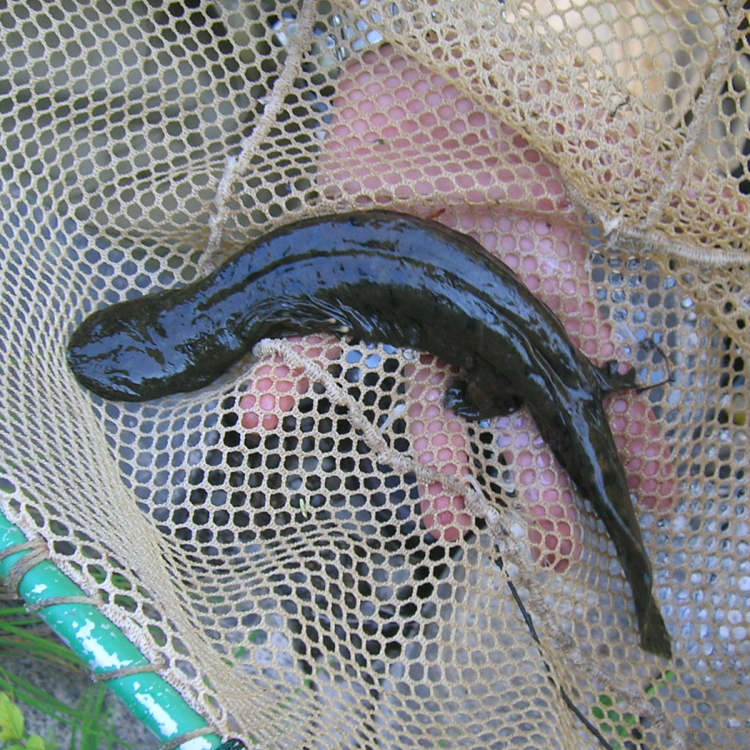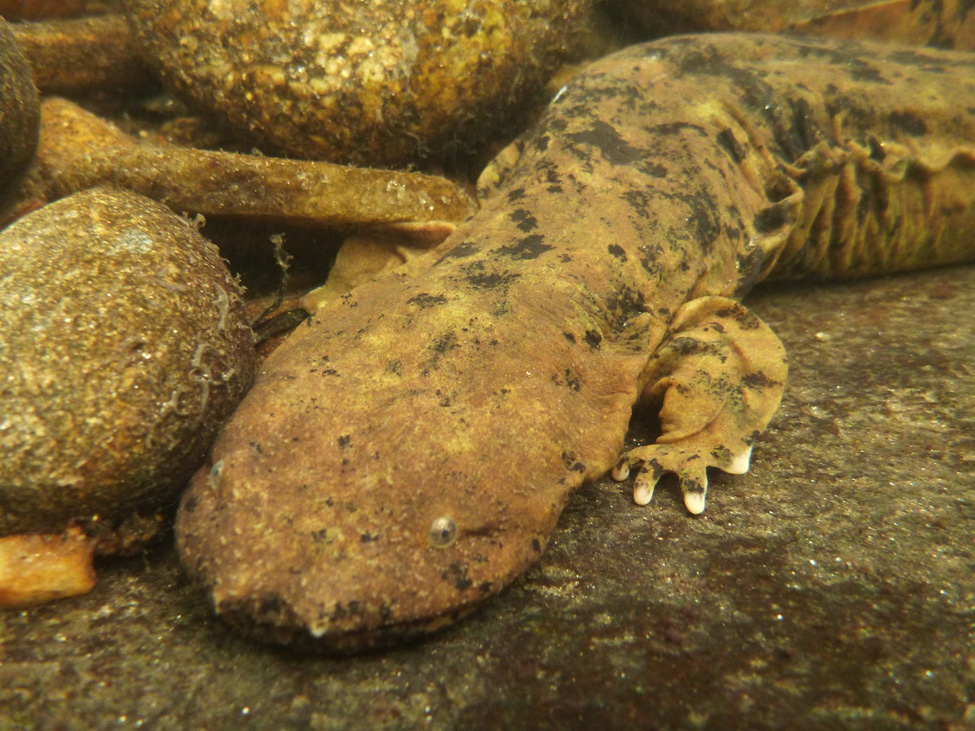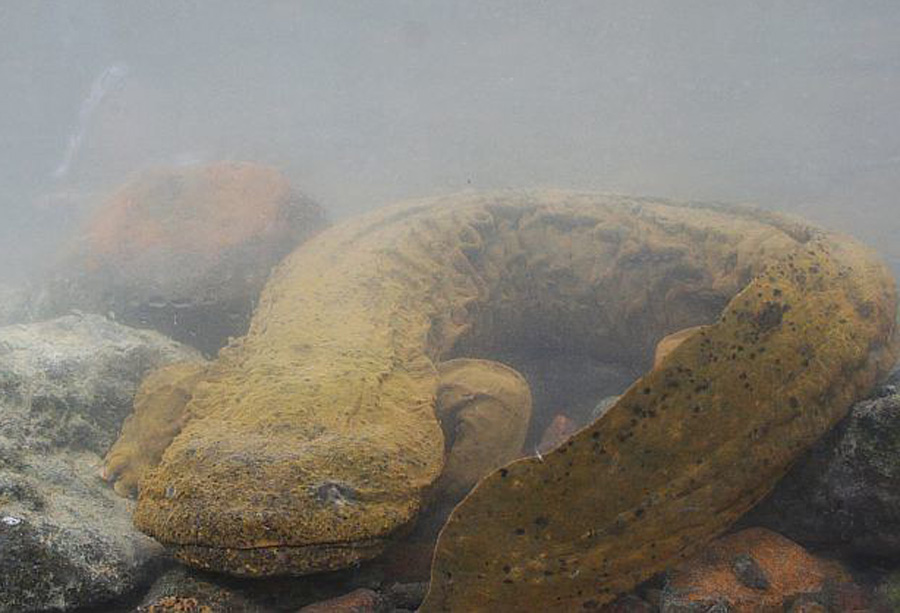The Eastern Hellbender
Meet the Hellbender

The eastern hellbender is a giant salamander that may look like a monster with its long, lizard-like body, wrinkled skin, two pairs of short legs, and flattened body. However, this harmless creature is a vital part of the river ecosystem in the eastern United States.
Because it is sensitive to silt and pollution, the hellbender is an indicator of excellent water quality and is now only found in a handful of waterways. In 2019, the eastern hellbender officially became the state amphibian of Pennsylvania, a designation that promotes the need to restore water quality and preserve habitat for this unique amphibian.
Photo: Eastern Hellbender, Lycoming Creek, Lycoming County, PA (SRBC)The Hellbender: Flagship Species for Clean Water
 Credit: Southern Appalachian Gathering 2018)
Credit: Southern Appalachian Gathering 2018)
The hellbender is not known for its beauty. One of two subspecies of hellbender, the eastern hellbender (Cryptobranchus alleganiensis) has a flat body and head, a long and paddle-like tail, and its brown/ copper-brown/black skin is mottled and slimy. Each of its toes has a hardened tip that help the hellbender to grip and move around on rocky riverbeds
Most salamanders leave the water, but hellbenders are fully aquatic and never or rarely go on land. They prefer rocky streambeds, submerged boulders, and big flat rocks in shale formations where they can hide under large rock slabs for shelter and food. They have small teeth and prey mostly on crayfish
Hellbenders like fast-flowing, highly oxygenated water because they get oxygen by exchanging gases through their skin. The folds and wrinkles in their skin increase their bodies’ total surface area which aids the breathing process.
Sensitive Creatures
The need to draw oxygen from the water is one reason hellbenders are sensitive to changes in water quality. Streams that lose tree canopy along their shorelines often have higher water temperatures and less available dissolved oxygen.
Changes in the water chemistry from chemical and nutrient pollutants and abandoned mine drainage can also interfere with the hellbender’s breathing physiology.
Other stressors include sediment that buries nesting and foraging habitat and dams that eliminate free-flowing water and produce low oxygen conditions on the river bottom. Frequent flooding can also degrade a rocky stream bottom.
In short, hellbenders have to have clean water to survive
Misunderstood Amphibian
Historically, fishermen killed hellbenders because they believed that hellbenders ate large quantities of fish, despite the fact that hellbenders mainly eat crayfish. In the early 1920s and 1930s, a bounty of twenty-five cents per hellbender was established in some areas. In the last few decades, hellbenders have also been illegally collected, often to sell. Today, hellbenders are much less prevalent in the Susquehanna watershed than in the Ohio River watershed.
(Source: Shaver’s Creek Environmental Center)Helping the Hellbender
A number of research institutions and conservation organizations are working to protect hellbender habitat and reintroduce populations to suitable habitat.
The Wildlife Conservation Society’s Bronx Zoo has worked with the New York State Dept. of Environmental Conservation (NYSDEC) and regional conservation groups to collect and hatch hellbender eggs and release larvae back into the wild.
Lycoming College worked with the Chesapeake Bay Foundation’s Student Leadership Council to set up concrete nesting boxes to collect hellbender eggs for the Bronx Zoo’s hatch and release efforts. (This led to the initiative to name the eastern hellbender as the PA state amphibian.)
The Western PA Conservancy continues to survey hellbender populations on a number of western PA rivers.
The Wetland Trust has protected 128 acres along two Susquehanna “hellbender” tributaries and intends to buy additional critical riparian buffer lands as properties become available.
Cornell Wildlife Health Lab has worked with NYSDEC to research fungal infection issues that have plagued release efforts in New York. Alternate release strategies with vaccinated and unvaccinated hellbenders are being tested using radio-tracking.
 Credit: Andrew Hoffman, 2006
Credit: Andrew Hoffman, 2006
Quick Facts
- Other names for the eastern hellbender: snot otter, mud devil, water dog, lasagna lizard, devil dog, grampus, Allegheny alligator, mud dog
- The hellbender is the largest amphibian in North America reaching up to 29 inches in length and weighing up to 5.5 pounds.
- Average adult length: 12 – 15 inches
- Lifespan: 30-50 years
- Light-sensitive cells from head-to-tail ensure that no part of its body is exposed when hiding under rocks in a stream.
- Juveniles have external gills, which they lose upon growing between 4–5 inches long (at approximately 18 months of age).
What You Can Do
Don't Move the Rocks
If you are wading in a stream that might be clean enough for hellbenders to thrive, do not remove or flip rocks or disturb the streambed. If you do see a hellbender, do not disclose the exact location. Hellbenders are sometimes illegally collected and sold as pets, so be discreet about sharing its location.
If you are fishing and accidentally catch a hellbender, release the animal back into the water by first cutting the fishing line as close to its mouth as possible or remove the hook with a pair of pliers.
Watch The Last Dragons - Protecting Appalachia's Hellbenders video for some great underwater footage of hellbenders.